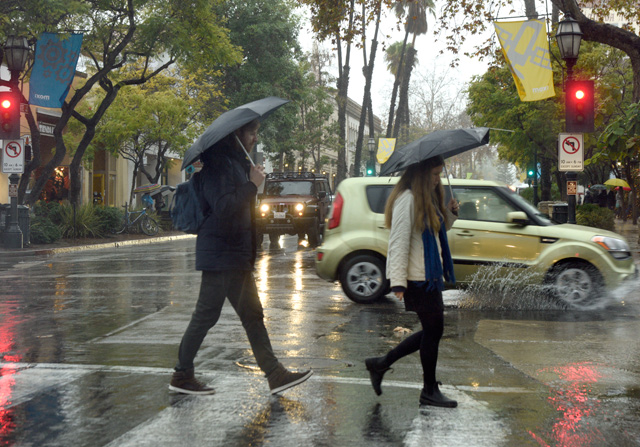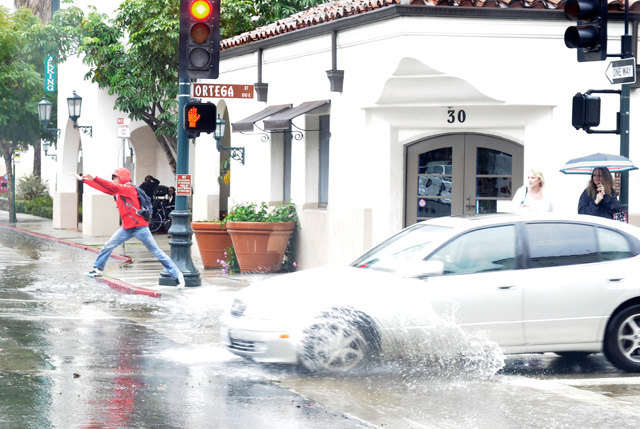More Rain Means Less Water Stored for Santa Barbara
Desal Cost Overrun Hits $15 Million

For City of Santa Barbara water czar Joshua Haggmark, cruel ironies are piling up fast and furious. The good news, of course, is that it’s raining — so hard and sustained, in fact, that for the first time in many moons, there’s water running down the Santa Ynez River and into Lake Cachuma. The bad news, less obviously, is that the rain is falling most plentifully on the wrong side of the mountains, away from the three reservoirs upon which South Coast water agencies rely.
This week’s wet optics provided a particularly inauspicious backdrop for Haggmark to drop his latest bombshell on city councilmembers over the escalating price tag for rebuilding the city’s long-mothballed desalination plant. The desal plant, he revealed, will cost $15 million more to build than the $55 million initially projected and nearly $10 million more than the last time he reported $6 million in cost overruns.
The start-up date for plant production has been pushed back yet again, this time to somewhere between mid-February to mid-March. Initially, the plant was slated to become operational October 4. For some councilmembers, sticker shock quickly became shell shock. “This is a $15 million oops we’ve got here,” thundered Councilmember Frank Hotchkiss. “That’s a lot of money.”
Haggmark explained that drawings of the plant provided by Ionics, the company that built the original facility back in 1992, bore little relationship to what construction crews were encountering now. Hotchkiss charged “fraud” and wanted to know if the city could sue. He was informed that Ionics has long been out of business and that fraud would be exceptionally hard to prove.
After asking a series of pointed questions, Councilmember Jason Dominguez argued that neither the current contractor nor the company City Hall hired to manage the construction project had any incentive to control costs or finish the work in a timely manner. Both Dominguez and Hotchkiss questioned whether money could be saved by farming out some of the work via competitive bids. To open any portion of the project to bids, Haggmark replied, would delay start-up by at least three more months.

The cruelest irony of them all that Haggmark never got around to telling the council is this: The heavy rains now pummeling Northern California are threatening to cause 30,000 acre-feet of emergency water that Santa Barbara water agencies have stored in the San Luis Reservoir — located 12 miles west of Los Baños — to disappear. That the logic seems counterintuitive in the extreme does not make the threat any less dire.
Over the years, all the area water agencies that are hooked into the State Water Project and that belong to the Central Coast Water Authority (CCWA) purchased emergency water and stored it in the San Luis Reservoir, the fifth largest in California. But by contractual agreement, once San Luis fills to the brim, all storage capacity disappears, and in the parlance of water managers, a “theoretical spill” has occurred. This means any stored water is lost. The Montecito Water District has 8,000 acre-feet stored in San Luis, roughly twice what the agency produces in a year. The City of Santa Barbara has about 5,500 acre-feet parked there, roughly two-thirds what it’s currently using.
It’s little wonder then that the Montecito district held a special emergency meeting Monday. District manager Nick Turner said in a worst-case scenario, it could transfer its stored water to a reservoir controlled by the Irvine Water District. But the cost in water charged to make such a transfer happen is expensive, and Montecito could salvage only 40 percent.

The San Luis Reservoir is shared by the California Department of Water Resources and the federal Bureau of Reclamation. In the highly convoluted and equally counterintuitive world of water storage, the Bureau of Reclamation may have storage space in the San Luis Reservoir even if the state’s capacity has “spilled.” In that eventuality, South Coast agencies might be able to “park” some of their stored water with the feds. That’s an iffy solution at best.
When this news trickled down to water district managers late last Thursday, they were notified odds were better than 50 percent the San Luis Reservoir would spill by the end of January. But with the arrival of the Pineapple Express last week, all bets were off.



